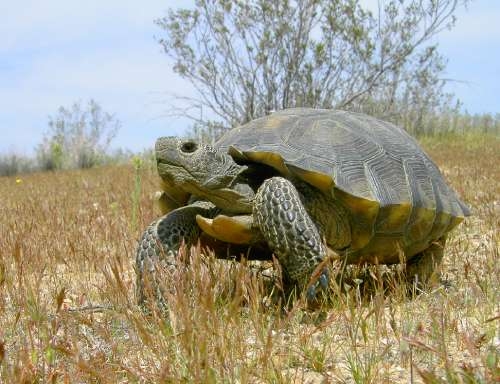- Home
- About S&T
- Taxa/Organisms
- Ecosystems
- Issues
- Methods & Tools
- Reports & Publications
- Location
- Search
May 21 2009 | Publisher: USGS | Format: URL
pubs.usgs.gov — A new tool provides land managers with a predictive model for mapping the potential distribution of desert tortoise habitat and to evaluate different land-use issues the tortoises face at a landscape scale. The model incorporates an extensive amount of field data for desert tortoises, as well as environmental data related to landscape attributes, More...

December 2008 | Publisher: USGS | Format: URL
soundwaves.usgs.gov — Kristen Hart and Keith Ludwig of the USGS Florida Integrated Science Center (FISC) participated in two research cruises in 2008 to study patterns of habitat use by endangered sea turtles in and around the National Park. Hart's research effort focuses on quantifying patterns of sea turtle habitat use, employing capture-recapture and satellite- and More...

June 2003 | Publisher: USGS | Science Center: Western Ecological Research Center (WERC, Sacramento) | Format: URL
www.werc.usgs.gov — Instructions for ordering equipment and culture media; summary of how to draw blood and conduct nasal lavages; and information on how to contract for laboratory analysis and ship laboratory samples.

March 2003 | Publisher: USGS | Science Center: Patuxent Wildlife Research Center (PWRC, Laurel) | Format: .PDF
www.pwrc.usgs.gov — Summary of Patuxent Wildlife Research Center's progress to assess the status of Northern diamondback terrapins in the Chesapeake Bay. PWRC's objectives included providing "information on current habitat type and activities of the diamondback terrapin," and evaluating "the genetic relatedness, levels of gene flow and degree of isolation of More...

June 2001 | Publisher: USGS | Science Center: Western Ecological Research Center (WERC, Sacramento) | Format: URL
www.werc.usgs.gov — Salvage of injured, recently dead, ill, and dying desert tortoises is a very important part of recovery programs for these reptiles. Salvaged desert tortoises can provide a wealth of information about such subjects as health, disease, presence of heavy metals and other toxicants, and causes of mortality in populations. When tortoises are salvaged More...

Publisher: USGS | Science Center: Western Ecological Research Center (WERC, Sacramento) | Format: URL
www.werc.usgs.gov — This project started to conduct an extensive review of the literature pertaining to restoring degraded desert tortoise habitat, with emphasis on the Mojave Desert. Recovery to pre-disturbance plant cover and biomass may take from 50-300 years while complete ecosystem recovery may require over 3,000 years. Restoration can be used to enhance the More...

Publisher: USGS | Science Center: Western Ecological Research Center (WERC, Sacramento) | Format: .PDF
www.werc.usgs.gov — One cause for declines in desert tortoise populations is predation on juveniles by common ravens (Corvus corax), a predatory bird species native to the Mojave Desert. The Recovery Plan for the Desert Tortoise recommended that research be conducted on sources of mortality (including natural predation). This study was implemented to investigate the More...

Publisher: USGS | Science Center: Southwest Biological Science Center (SBSC, Flagstaff) | Format: URL
sbsc.wr.usgs.gov — The desert tortoise is listed as a threatened species under federal and California versions of the Endangered Species Act. The recovery plan for the desert tortoise recommended that additional data be collected on the reproductive ecology of the species throughout the range. Annual meetings between USGS, Biological Resources Division researchers More...

Publisher: USGS | Science Center: Forest and Rangeland Ecosystem Science Center (FRESC, Corvallis) | Format: URL
fresc.usgs.gov — Description of a project to survey and monitor the western pond turtle, a species in Oregon's critical list. Includes statement of problem, objectives, methodology, related publications, and contact information.

Publisher: USGS | Science Center: Columbia Environmental Research Center (CERC, Columbia) | Format: .PDF
www.cerc.usgs.gov — Following the Kemp's Ridley on their perilous trek from Padre Island National Seashore, TX, where they are establishing a secondary nesting colony, to the Gulf of Mexico, is tricky business. Satellite transmitters are attached to a select number of females returning to the sea after laying eggs, their movements tracked by receivers picking up the More...

Publisher: USGS | Format: URL
geochange.er.usgs.gov — Overview of how climate change could impact turtles. Focuses particularly on environmental sex determination (ESD), and the potential of climate change to alter the sex ratio of turtle populations via ESD.

Publisher: USGS | Science Center: Southwest Biological Science Center (SBSC, Flagstaff) | Format: URL
sbsc.wr.usgs.gov — This resource is a summary of the research related to the western pond turtle in the Mojave River. The western pond turtle (Clemmys marmorata) is protected by the State of California and recent surveys have confirmed that many populations have been extirpated or are declining, particularly in southern California. Threats to the continued survival More...
